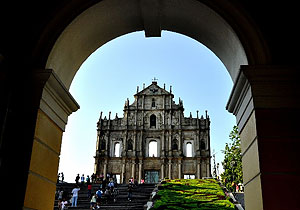Ruins of St Paul's Church

St. Paul's Church was first built by the Jesuits in 1580 but burnt down in 1601. In 1602 reconstruction began and was finally completed in 1637, resulting in the biggest Catholic church in Asia at the time. It was next to the Jesuit College of St. Paul, said to be the first western college in Asia.
Records say the church was made of white stone, had three beautifully decorated halls and a vaulted roof. A typhoon in 1835 caused another fire which burnt the college and church leaving only the church's front facade, crypt and steps. As it was never restored, this is all we see today.
The facade is 27m high, 23m wide and 2.7m thick. Its 4 stories were wonderfully decorated with carvings by locals and exiled Japanese Christians who followed the design of Italian Jesuit Carlo Spinola. Some of the features include a dove on top, a statue of Madonna in the center of the third level and Jesus directly above on the fourth level as well as saints, crucifix and other Catholic imagery. Some Chinese influences are dragons and inscriptions in Chinese characters.
Despite calls to knock down the dangerously leaning ruins, they were reinforced and the crypts excavated between 1990 and 1995. Plans of the church were discovered along with crypts of clergy, Japanese martyrs and other religious artifacts. The Museum of Sacred Art and Crypt was built next to the ruins and displays some of the discoveries. A stairs was also built behind the facade that allows you to climb up and get a better look at the top from the back.